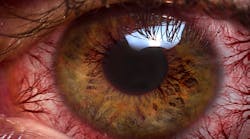Most Americans Experience Digital Eye Strain from Overexposure to Computers
The average U.S. worker spends seven hours a day on the computer either in the office or working from home and the American Optometric Association's (AOA) American Eye-Q® survey reports that 58 percent of adults have experienced digital eye strain or vision problems as a direct result.
Symptoms of digital eye strain, also known as computer vision syndrome, include eyestrain, headaches, blurred vision, dry eyes and neck and shoulder pain. The AOA recognizes the need to address this issue, encouraging both employees and employers to make eye health a priority. The five tips below easily can be implemented in most office spaces:
Follow the 20-20-20 rule: Take a 20-second break, every 20 minutes and view something 20 feet away.
Keep a distance: The AOA recommends sitting a comfortable distance from the computer monitor where you can easily read all text with your head and torso in an upright posture and your back supported by your chair. Generally, the preferred viewing distance is between 20 and 28 inches from the eye to the front surface of the screen.
View from a different angle: Ideally, the computer screen should be 15 to 20 degrees, or about 4 to 5 inches, below eye level as measured from the center of the screen.
Decrease glare: While there is no way to completely minimize glare from light sources, consider using a glare filter. These filters decrease the amount of light reflected from the screen.
Blink often: Minimize your chances of developing dry eyes when using a computer by making an effort to blink frequently.
"As more people spend their days at work on a computer and their free time on handheld devices, doctors of optometry are seeing more patients who are experiencing digital eye strain," said Steven A. Loomis, O.D., immediate past president of the AOA. "The problem can be relieved by taking simple steps. Just looking away from the computer for brief periods of time throughout the day can help with discomfort and long term eye problems."
Additional findings on technology and eye health from the AOA Eye-Q Survey include:
- 59 percent of those surveyed responded that a desktop computer or laptop was the device that bothered them most. Mobile phones were second at 26 percent, followed by tablets at 8 percent.
- 61 percent of people surveyed admit to using multiple digital devices at the same time.
- 56 percent responded that their primary use for digital devices is entertainment (reading, watching movies or shows and video games).
- 76 percent of people know that blue light from digital devices affects vision.

